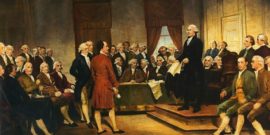The Enduring Value of Calhoun
Both John C. Calhoun and Woodrow Wilson have recently been canceled by major universities. Yale’s Calhoun College is now Grace Hopper College and the former Woodrow Wilson School at Princeton awaits a new donor for renaming. It is striking that the monikers of two of the three most brilliant scholar-statesmen in American history have erased from the universities—the place where ideas are supposed to hold pride of place. Can the third member of this triumvirate, James Madison, father of the Bill of Rights but unrepentant slaveholder, persist at James Madison University and other institutions?
It is one of the many sound observations in Robert Elder’s new biography, Calhoun: American Heretic, that essential perspectives on American history disappear when a cordon sanitaire is erected around important figures with ideas that make us uncomfortable. This is particularly the case with Calhoun, because while his defense of slavery is abhorrent, his innovative thoughts on the nature of democracy remain as interesting and vital as the day he wrote them. Indeed, his idea that democracy works only when the government acts on the basis of “concurrent majorities”—a widespread consensus that encompassed all substantial interests—has loud echoes in important modern political theorists. It may be that a political structure that depends on consensus offers the best prospect of social stability in a polarized time like ours.
An Ambition That Knew No Rest
Elder’s biography is excellent at showing how Calhoun’s ideas grew from his own personal and political trajectory. The key to understanding Calhoun is to recognize the propelling combination of intellect and ambition. He wanted to be a great figure on the political stage from an early age and subordinated the rest of his life to that end.
He was born in relatively modest circumstances to a family that owned land in the upcountry—the more mountainous and hard-scrabble part of South Carolina. The upcountry was politically and culturally distinct from the low country—the more fertile and prosperous part of the state near the coast, featuring vast plantations and wealthy grandees. Uniting these disparate parts of the state was the primary goal of state constitution-making and gave Calhoun from his earliest years a sense of the need to find mechanisms that brought together divergent interests.
While Calhoun’s immediate family was only of the middling sort, it had valuable connections in its more extended branches. A rich cousin, John E. Colhoun, was a United States Senator from South Carolina. On his death, the younger John befriended his widow and then married her daughter, making him independently wealthy. Elder suggests that the union was ultimately one more of calculating practicality than deep affection. Calhoun was an intellectual and his wife was a socialite. Most of his children were also a disappointment to him. The great exception was his daughter, Anna. Calhoun believed strongly in the education of women—not a common view at the time—and in his later years, Anna provided the vibrant companionship that his wife could not.
But Calhoun spent much of his life away from his family either in the state capital of Columbia or the nation’s capital. He was continuously in office for almost 40 years, first as a state legislator, then U.S. Congressman, then U.S. Senator, with time out to be Secretary of War, Secretary of State, and Vice President under two different Presidents—John Quincy Adams and Andrew Jackson—one of only two men in American history to straddle administrations in that role.
During his long career, he moved from being a nationalist to a strong proponent of state rights, although never an advocate of disunion. His early nationalism was motivated by an enthusiasm for national greatness and national security. Elder sums up that in his early career, “Self-interest, strength and pride were Calhoun’s recipe for a durable union.” As a Congressman, he was part of the faction of the Democratic-Republican Party that supported internal improvements to boost economic growth and caustically criticized the extreme states’ rights wing, led by John Randolph. As Secretary of War, he favored a strong, modernized military and reorganized the army to become a far more effective fighting force. As Elder wryly notes, in the Civil War, “The South would have Calhoun’s arguments, but the North would have his war machine.”
But events made his strong nationalism incompatible with representing South Carolina and maintaining a Southern base for a presidential run. Strong national power not only potentially threatened slavery but justified protective tariffs for northern manufacturing. Those tariffs put up the price of manufactured goods, thus harming Southerners directly, and deprived the British of income from manufacturing that could be used to buy cotton, thus harming them indirectly as well.
Calhoun’s specific interventions against tariffs and in favor of slavery are matters of historical interest, but little contemporary resonance. His Disquisition on Government, however, is timeless.
This so-called “tariff of abominations” led Calhoun to support nullification of the levy by South Carolina on the theory that the Constitution did not give Congress power over tariffs for protectionist purposes, only revenue-raising ones. In his view, the latter kind of tariffs contributed to the public good of running the government, but the latter infringed on liberty. This debate over economic policy provided the background to the most famous pair of dueling toasts in American history. At the Jefferson Day dinner in 1830, President Andrew Jackson raised his glass “To Union.” And Vice President Calhoun responded, “To Union—after our Liberty, most dear.”
But when Calhoun resigned late in Jackson’s presidency to return to service in the Senate, he was by no means the most fire-breathing of nullifiers in his state. As Elder correctly notes, he sought compromises to preserve the union, just as he had welcomed compromises in his youth that had preserved the balance of power between the upcountry and the low country in South Carolina. He even supported internal improvements so long as they were connected to the navigable waters, seeing them as ties to bind the country together.
Calhoun’s Political Theory
Calhoun’s specific interventions against tariffs and in favor of slavery are matters of historical interest, but little contemporary resonance. His Disquisition on Government—a posthumous work of political theory—however, is timeless. It was motivated by Calhoun’s concern to keep the union together against the specific threats of his time, but, like any great work of politics, it abstracted from the specific circumstances of its creation to offer a more general analysis of the relation of man to society.
Calhoun begins with the observation that man is social yet self-interested. One of the virtues of his analysis is that he anticipates the Darwinian view that it is the essence of human nature to regard our individual welfare as more important than the common good. This wedge between individual self-interest and the need for society creates the essential problem of politics: how to reconcile the liberty that our interest demands with the need for a social structure that prevents our partiality from harming others. His human psychology thus is more Hobbesian than Lockean.
Unlike Hobbes, however, Calhoun believes in a system that can keep a society together through the consent of the governed rather than an absolute ruler. But if liberty is to be protected in democracy, the consent of the governed cannot come through mere majority rule even in a large republic like the United States. Here he disagrees with Madison’s famous view in Federalist 10 that the large republic with its multiple, circulating factions will prevent majority tyranny, because parties will form these factions into cohesive blocs that seek to wield power on their own behalf, often oppressing minority interests.
The solution is to assure that minority interests must consent to the actions of government. Requiring what he called a “concurrent majority” will encourage compromise and ensure that the overwhelming majority have a stake in the continued union of the polity.
Elder’s exposition of Calhoun’s theory is clear and respectful. He quotes Mill as calling Calhoun “a man who has displayed powers as a speculative political thinker superior to any who has appeared” on the new continent. Nevertheless, as a historian rather than a political scientist, Elder neither offers a substantial critique of Calhoun’s theory nor recognizes its descendants in contemporary political science.
In my view, the great problem with Calhoun’s theory is that he has no way of telling which interests must consent to make a majority sufficiently “concurrent” and to allow the government to act. Calhoun had a dynamic view of society, but interests change. Some become anachronistic or too small to require that they be reflected in a governing consensus.
But modern public choice builds on Calhoun. It shares his emphasis on self-interest as the prime mover in politics and the necessity of structuring the polity to require widespread consent before important actions by government. Both Mancur Olson’s emphasis on empowering an encompassing interest of society to increase economic growth and James Buchanan’s endorsement of consensus rules for governance have a family resemblance to Calhoun’s analysis. Like him, they focus on government structures that require more than mere majoritarian support, even if the institutions they choose are different from those he recommended, as when they require legislatures to pass their important enactments by strong supermajorities.
Elder’s volume has a few flaws. He mistakenly suggests that the Twentieth Amendment killed lame-duck sessions of Congress. But these gatherings continue until this day. And after describing the fascinating arc of companionship between Calhoun and Anna—the most important personal relation of his life, he does not tell us what became of her after Calhoun’s death, although he does describe the fate of a few of his other, less consequential children.
While Elder might have probed a little more the depth of Calhoun’s powerful political theories, his is an excellent and judicious biography. He shows Calhoun as a man of his time, liable to substantial criticism for his claims that were seen as outlandish even by many Southerners—that slavery was a positive good—but not some kind of devil incarnate. Calhoun was ultimately a tragic figure who tried to use his powerful mind to save the union that he loved but that his very imperfect understanding of liberty would help rend asunder. It a great mistake to overlook his political theory because of his political mistakes. however. Ironically, the consensus-creating government he advocated might help temper the very discontents that are obscuring his substantive legacy.

